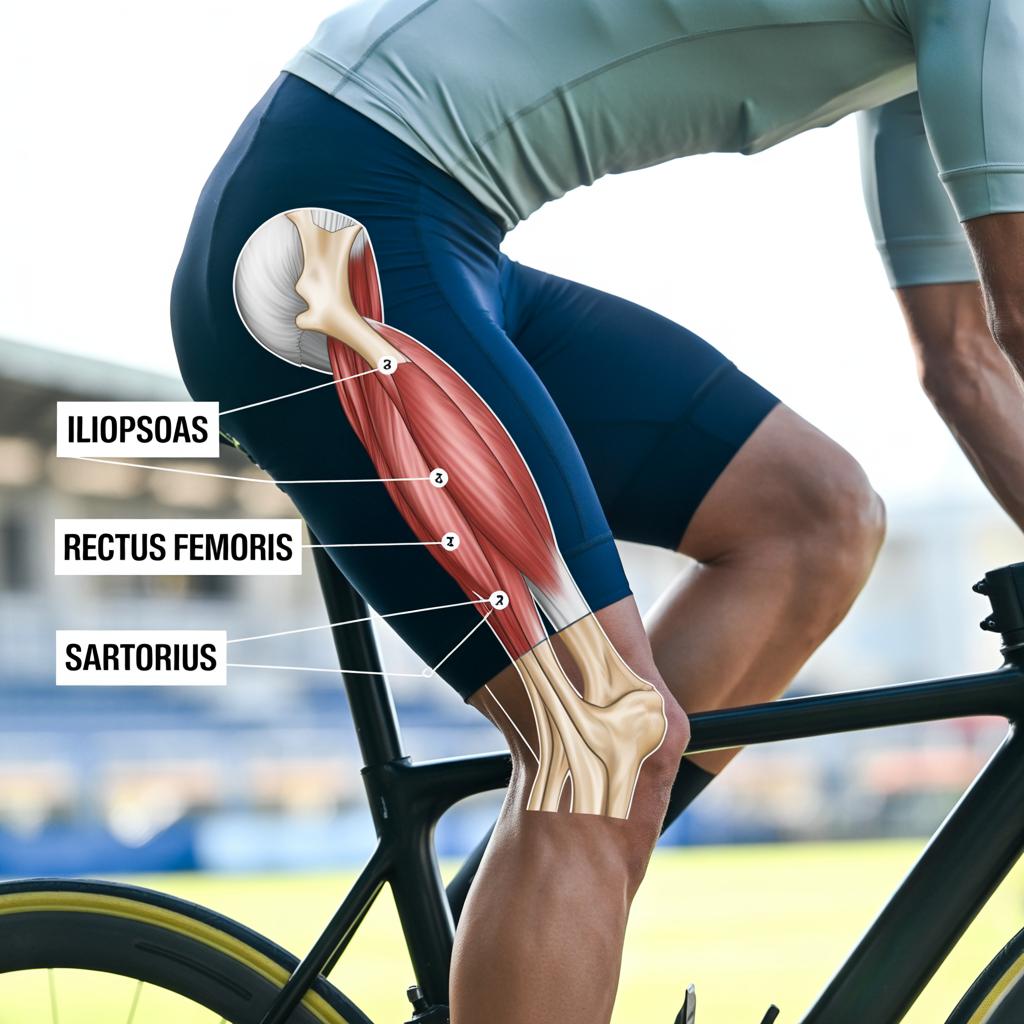Yes, cycling works your hip flexors—these crucial muscles are engaged every time you pedal, especially when lifting your knee towards your chest. Understanding how cycling affects your hip flexors can help you prevent tightness, boost your cycling performance, and avoid common injuries. Many cyclists experience hip flexor tightness or discomfort due to repetitive motion and posture, but knowing how to manage this ensures you stay strong and flexible.
In this article, you’ll learn:
- Exactly how cycling uses the hip flexors
- Signs of tight or overworked hip flexors
- The best ways to stretch and strengthen these muscles
- Tips to prevent injury and maximize your cycling benefits

For official guidelines on muscle health and injury prevention, check resources from the American Academy of Orthopaedic Surgeons.
What Are the Hip Flexors?
Anatomy of the Hip Flexors
The hip flexors are a group of muscles that bring your thigh toward your abdomen. The main muscles include:
- Iliopsoas (iliacus + psoas major)
- Rectus femoris (part of your quadriceps)
- Sartorius
- Tensor fasciae latae
Why Are Hip Flexors Important for Cyclists?
Your hip flexors are essential for the upward motion in cycling. When you pedal, these muscles help lift your knee and stabilize your hips, supporting a smooth, efficient stroke (Bicycling Magazine, 2024).
Does Cycling Work the Hip Flexors?
How Cycling Engages Hip Flexors
Cycling consistently works the hip flexors. During each pedal stroke, especially in the “up-stroke” phase, your hip flexors contract to pull your knee upward. This motion is repeated thousands of times per ride, making these muscles both strong and susceptible to tightness (BikeRadar, 2024).
- The seated cycling position keeps hip flexors active and slightly shortened.
- Improper bike fit can further stress the hip flexors.
- Overuse or lack of stretching can lead to muscle imbalances.
Common Issues: Tightness & Imbalance
Why Do Cyclists Get Tight Hip Flexors?
Cyclists often experience tight hip flexors because of the repetitive motion and seated posture, both on the bike and during daily life (e.g., working at a desk). This can lead to:
- Reduced range of motion
- Weakness in opposing muscles (glutes, core)
- Lower back pain and hip discomfort
Recent studies and trainers confirm that hip flexor tightness is a top complaint among cyclists, and it’s even more pronounced with improper bike fit or long rides (TrainerRoad Forum, 2024).
How to Prevent Tightness and Injury
1. Stretch Your Hip Flexors Regularly
Simple, effective stretches:
- Couch stretch
- Lunge stretch
- Standing quad stretch
Aim to stretch after every ride and during rest days.
2. Strengthen the Whole Chain
Balanced strength is critical. Combine hip flexor strengthening with core and glute exercises:
- Single-leg raises
- Dead-bugs
- Glute bridges
3. Review Your Bike Fit
A proper bike fit minimizes stress on your hips. Consider professional fitting if you notice persistent tightness.
4. Take Active Recovery Days
Mix in walking, swimming, or yoga to help your hip flexors recover and maintain flexibility.
Best Hip Flexor Exercises for Cyclists
| Exercise Name | Benefits | How-To (Brief) |
|---|---|---|
| Couch Stretch | Increases flexibility | Kneel, foot against wall, lunge forward |
| Lunge Stretch | Opens hips, relieves tension | Step forward into deep lunge |
| Glute Bridge | Strengthens glutes & hips | Lie back, lift hips, squeeze glutes |
| Standing Leg Raise | Targets hip flexors specifically | Stand, lift knee up, hold, lower |
For more details, check the American Council on Exercise.
Frequently Asked Questions
Q: Can cycling cause hip flexor pain?
A: Yes. Overuse, poor posture, or improper bike fit can lead to hip flexor pain. Prevent it by stretching, strengthening, and ensuring your bike fit is correct.
Q: How do I know if my hip flexors are tight?
A: Signs include lower back soreness, reduced hip mobility, and discomfort during or after riding. Try a lunge stretch—if you feel a strong pull, your hip flexors may be tight.
Q: Should I stop cycling if my hip flexors hurt?
A: Rest and gentle stretching are key. If pain persists, see a physical therapist and review your bike fit.
Conclusion
Cycling absolutely works your hip flexors—sometimes a little too well! By understanding how these muscles function, stretching regularly, and balancing your training, you can ride stronger and avoid hip flexor pain. Prioritize your recovery, get your bike professionally fitted, and integrate strength exercises for lasting performance gains.
